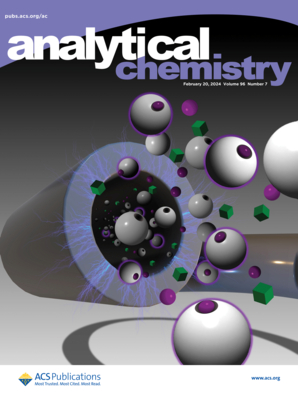用于超灵敏电化学生物传感的高效熵驱动交叉双环反应级联CRISPR/Cas12a切割
IF 6.7
1区 化学
Q1 CHEMISTRY, ANALYTICAL
引用次数: 0
摘要
传统CRISPR/ cas12a切割系统的信号扩增效率有限,主要是由于crRNA的结构限制和单触发激活。为此,我们开发了一种高效的靶向诱导熵驱动的交叉双环链位移反应(SDR)级联不对称CRISPR/Cas12a切割,构建了一种超灵敏、可靠的信号关闭电化学生物传感器。理想的熵驱动调制可以自发地进行具有自加速能力的交叉双环反应,有效地提高了链替换率,避免了额外燃料链的使用,产生了两个丰富的不同DNA输出,显著提高了靶转化效率。更重要的是,在不对称CRISPR/Cas12a系统中,所有靶点和两种不同的DNA输出可以同时作为激活剂,与分裂和全尺寸crrna协同结合,实现二铁标记单链DNA (fc -报告基因)在电极上的高效放电,从而显著提高检测灵敏度和可靠性。实验结果表明,该传感器具有从1 fM到1 nM的宽线性范围,检测限低至0.23 fM。通过将熵驱动扩增与crispr增强的信号转导相结合,本研究建立了一种多功能且强大的早期癌症诊断和精确生物分子检测分析工具。本文章由计算机程序翻译,如有差异,请以英文原文为准。
Efficient Entropy-Driven Cross-Double-Loop Reaction Cascade Asymmetric CRISPR/Cas12a Cleavage for Ultrasensitive Electrochemical Biosensing.
The limited signal amplification efficiency of the conventional CRISPR/Cas12a-cleavage system was primarily due to the structural constraints of crRNA and single-trigger activation. Herein, an efficient target-induced entropy-driven cross-double-loop strand displacement reaction (SDR) cascade asymmetric CRISPR/Cas12a cleavage was developed to construct an ultrasensitive and reliable signal-off electrochemical biosensor. The desirable entropy-driven modulation could spontaneously undergo a cross-double-loop reaction that possessed self-accelerating ability, effectively improving the rate of chain replacement and avoiding the usage of extra fuel chains with generation of two abundant distinct DNA outputs, significantly improving target conversion efficiency. More importantly, all the targets and two distinct DNA outputs could simultaneously act as activators in the asymmetric CRISPR/Cas12a system, which cooperatively bound to both split and full-sized crRNAs to accomplish the highly efficient discharge of ferrocene-labeled single-stranded DNA (Fc-reporter) on the electrode, thereby markedly improving the detection sensitivity and reliably compared to that of traditional ones. The experimental results suggested that the proposed biosensor had a wide linear range spanning from 1 fM to1 nM with a detection limit as low as 0.23 fM. By integrating entropy-driven amplification with CRISPR-enhanced signal transduction, this work established a versatile and robust analytical tool for early cancer diagnosis and precision biomolecular detection.
求助全文
通过发布文献求助,成功后即可免费获取论文全文。
去求助
来源期刊

Analytical Chemistry
化学-分析化学
CiteScore
12.10
自引率
12.20%
发文量
1949
审稿时长
1.4 months
期刊介绍:
Analytical Chemistry, a peer-reviewed research journal, focuses on disseminating new and original knowledge across all branches of analytical chemistry. Fundamental articles may explore general principles of chemical measurement science and need not directly address existing or potential analytical methodology. They can be entirely theoretical or report experimental results. Contributions may cover various phases of analytical operations, including sampling, bioanalysis, electrochemistry, mass spectrometry, microscale and nanoscale systems, environmental analysis, separations, spectroscopy, chemical reactions and selectivity, instrumentation, imaging, surface analysis, and data processing. Papers discussing known analytical methods should present a significant, original application of the method, a notable improvement, or results on an important analyte.
 求助内容:
求助内容: 应助结果提醒方式:
应助结果提醒方式:


